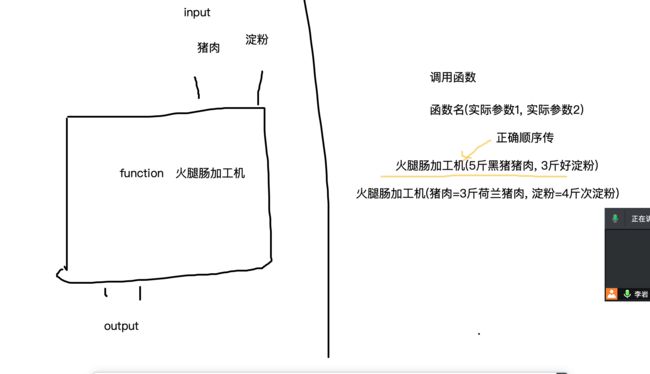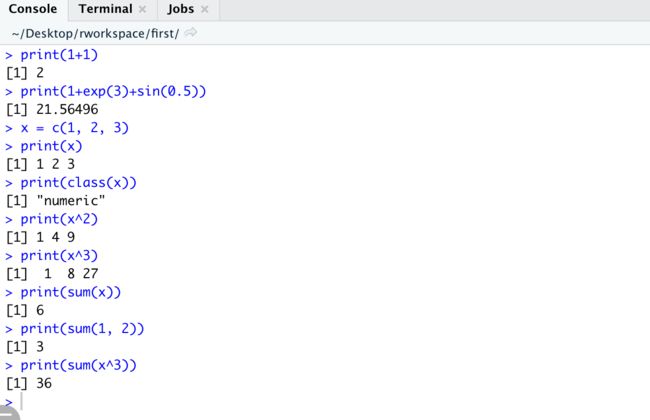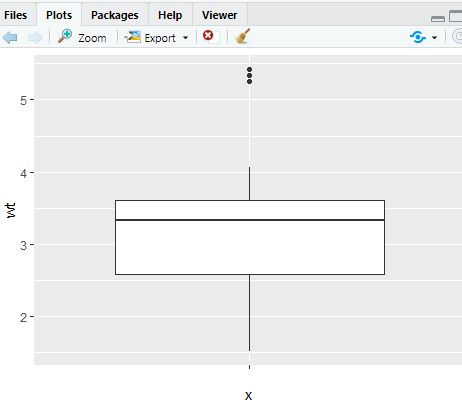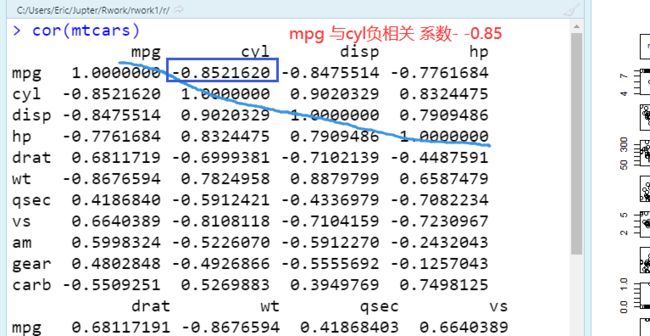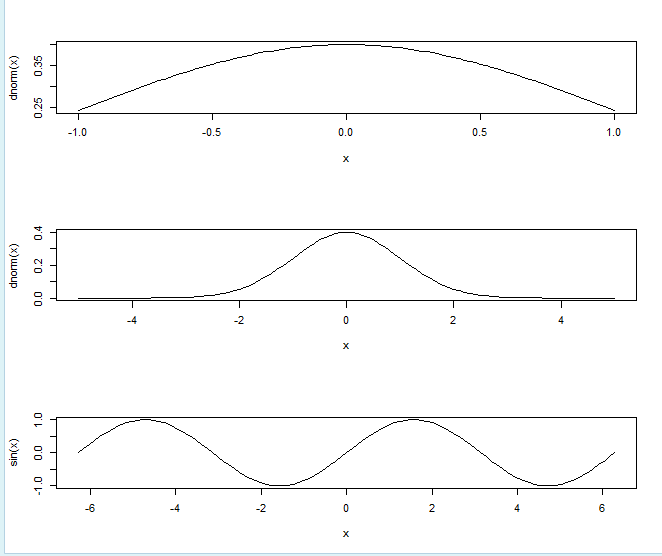R语言学习笔记
R可以作为计算使用
print(1+1)
print(1+exp(3)+sin(0.5))
x = c(1, 2, 3)
print(x)
print(x^2)
print(x^3)
print(sum(x))
print(sum(x^3))
print(sum(1, 2))
R中的数据集
向量
euro #欧元汇率,长度为11,每个元素都有命名
landmasses #48个陆地的面积,每个都有命名
precip #长度为70的命名向量
rivers #北美141条河流长度
state.abb #美国50个州的双字母缩写
state.area #美国50个州的面积
state.name #美国50个州的全称
因子
state.division #美国50个州的分类,9个类别
state.region #美国50个州的地理分类
矩阵、数组
euro.cross #11种货币的汇率矩阵
freeny.x #每个季度影响收入四个因素的记录
state.x77 #美国50个州的八个指标
USPersonalExpenditure #5个年份在5个消费方向的数据
VADeaths #1940年弗吉尼亚州死亡率(每千人)
volcano #某火山区的地理信息(10米×10米的网格)
WorldPhones #8个区域在7个年份的电话总数
iris3 #3种鸢尾花形态数据
Titanic #泰坦尼克乘员统计
UCBAdmissions #伯克利分校1973年院系、录取和性别的频数
crimtab #3000个男性罪犯左手中指长度和身高关系
HairEyeColor #592人头发颜色、眼睛颜色和性别的频数
occupationalStatus #英国男性父子职业联系
类矩阵
eurodist #欧洲12个城市的距离矩阵,只有下三角部分
Harman23.cor #305个女孩八个形态指标的相关系数矩阵
Harman74.cor #145个儿童24个心理指标的相关系数矩阵
数据框
airquality #纽约1973年5-9月每日空气质量
anscombe #四组x-y数据,虽有相似的统计量,但实际数据差别较大
attenu #多个观测站对加利福尼亚23次地震的观测数据
attitude #30个部门在七个方面的调查结果,调查结果是同一部门35个职员赞成的百分比
beaver1 #一只海狸每10分钟的体温数据,共114条数据
beaver2 #另一只海狸每10分钟的体温数据,共100条数据
BOD #随水质的提高,生化反应对氧的需求(mg/l)随时间(天)的变化
cars #1920年代汽车速度对刹车距离的影响
chickwts #不同饮食种类对小鸡生长速度的影响
esoph #法国的一个食管癌病例对照研究
faithful #一个间歇泉的爆发时间和持续时间
Formaldehyde #两种方法测定甲醛浓度时分光光度计的读数
Freeny #每季度收入和其他四因素的记录
dating from #配对的病例对照数据,用于条件logistic回归
InsectSprays #使用不同杀虫剂时昆虫数目
iris #3种鸢尾花形态数据
LifeCycleSavings #50个国家的存款率
longley #强共线性的宏观经济数据
morley #光速测量试验数据
mtcars #32辆汽车在11个指标上的数据
OrchardSprays #使用拉丁方设计研究不同喷雾剂对蜜蜂的影响
PlantGrowth #三种处理方式对植物产量的影响
pressure #温度和气压
Puromycin #两种细胞中辅因子浓度对酶促反应的影响
quakes #1000次地震观测数据(震级>4)
randu #在VMS1.5中使用FORTRAN中的RANDU三个一组生成随机数字,共400组。#该随机数字有问题。在VMS2.0以上版本已修复。
rock #48块石头的形态数据
sleep #两药物的催眠效果
stackloss #化工厂将氨转为硝酸的数据
swiss #瑞士生育率和社会经济指标
ToothGrowth #VC剂量和摄入方式对豚鼠牙齿的影响
trees #树木形态指标
USArrests #美国50个州的四个犯罪率指标
USJudgeRatings #43名律师的12个评价指标
warpbreaks #织布机异常数据
women #15名女性的身高和体重
列表
state.center #美国50个州中心的经度和纬度
类数据框
ChickWeight #饮食对鸡生长的影响
CO2 #耐寒植物CO2摄取的差异
DNase #若干次试验中,DNase浓度和光密度的关系
Indometh #某药物的药物动力学数据
Loblolly #火炬松的高度、年龄和种源
Orange #桔子树生长数据
Theoph #茶碱药动学数据
时间序列数据
airmiles #美国1937-1960年客运里程营收(实际售出机位乘以飞行哩数)
AirPassengers #Box & Jenkins航空公司1949-1960年每月国际航线乘客数
austres #澳大利亚1971-1994每季度人口数(以千为单位)
BJsales #有关销售的一个时间序列
BJsales.lead #前一指标的先行指标(leading indicator)
co2 #1959-1997年每月大气co2浓度(ppm)
discoveries #1860-1959年每年巨大发现或发明的个数
ldeaths #1974-1979年英国每月支气管炎、肺气肿和哮喘的死亡率
fdeaths #前述死亡率的女性部分
mdeaths #前述死亡率的男性部分
freeny.y #每季度收入
JohnsonJohnson #1960-1980年每季度Johnson & Johnson股票的红利
LakeHuron #1875-1972年某一湖泊水位的记录
lh #黄体生成素水平,10分钟测量一次
lynx #1821-1934年加拿大猞猁数据
nhtemp #1912-1971年每年平均温度
Nile #1871-1970尼罗河流量
nottem #1920-1939每月大气温度
presidents #1945-1974年每季度美国总统支持率
UKDriverDeaths #1969-1984年每月英国司机死亡或严重伤害的数目
sunspot.month #1749-1997每月太阳黑子数
sunspot.year #1700-1988每年太阳黑子数
sunspots #1749-1983每月太阳黑子数
treering #归一化的树木年轮数据
UKgas #1960-1986每月英国天然气消耗USAccDeaths #1973-1978美国每月意外死亡人数
uspop #1790–1970美国每十年一次的人口总数(百万为单位)
WWWusage #每分钟网络连接数
Seatbelts #多变量时间序列。和UKDriverDeaths时间段相同,反映更多因素。
EuStockMarkets #多变量时间序列。欧洲股市四个主要指标的每个工作日记录,共1860条记录。
查看数据
help(mtcars)
R中的包
install.packages("somepackage")
library("somepackage")
举个例子
install.packages("tidyverse")
library(tidyverse)
查看
View(iris)
数据结构
查看形状
dim()
查看列
names()
查看数据结构
str()
隔离变量(数据的筛选)
Structure of data
help(mtcars)
[, 1] mpg Miles/(US) gallon 油耗
[, 2] cyl Number of cylinders 气缸
[, 3] disp Displacement (cu.in.) 位移
[, 4] hp Gross horsepower 马力
[, 5] drat Rear axle ratio 后轴传动比
[, 6] wt Weight (1000 lbs)
[, 7] qsec 1/4 mile time
[, 8] vs Engine (0 = V-shaped, 1 = straight)
[, 9] am Transmission (0 = automatic, 1 = manual) 手动、自动
[,10] gear Number of forward gears 几个前进档位
[,11] carb Number of carburetors 化油器数量
dim(mtcars)
names(mtcars)
str(mtcars)
隔离变量
通过使用从数据框中选择一个变量DataName$VariableName并将结果存储在向量中。
mpg= mtcars$mpg
请注意,RStudio具有代码完成功能,因此将自动预测您的命令。当您键入时mtcars$,所有变量的名称都会出现。

class(mpg)
str(mpg)
length(mpg)
sum(mpg)
sort(mpg)
降序
sort(mpg, decreasing = T)
对变量的5个最低值求和。
sum(sort(mpg)[1:5])
选择子集
mpg[1]
mpg[5]
mpg[c(1,5)]
mtcars$mpg[c(1,5)]
mtcars[1,1]
mtcars[5,1] #mpg is 1st colu
变更分类
class(mtcars$carb)
carbF = factor(mtcars$carb)
class(carbF)
ageCanVote = factor(setNames(c(16, 18, 18, "Unknown"), c("Austria", "Australia", "Afghanistam", "Zambia")))
as.numeric(ageCanVote) # This is a mistake, as it converts to the rank of the factor level
as.numeric(as.character(ageCanVote)) # This converts properly
绘图
install.packages("ggplot2")
library(ggplot2)
柱状图绘制
查看32个样本的前进挡个数
> barplot(mtcars$gear)
table(mtcars$gear)
counts = table(mtcars$gear)
barplot(counts)
help(barplot)
barplot(counts, names.arg=c("3 Gears","4 Gears","5 Gears"),col="lightblue")
par(las=2)
barplot(counts, names.arg=c("3 Gears","4 Gears","5 Gears"),col="lightblue")
par(las=1)
barplot(counts, names.arg=c("3 Gears","4 Gears","5 Gears"),col="lightblue")
counts1 = table(mtcars$cyl, mtcars$gear)
barplot(counts1,names.arg=c("3 Gears","4 Gears","5 Gears"),col=c("lightblue","lightgreen","lightyellow"),legend = rownames(counts1))
barplot(counts1,names.arg=c("3 Gears","4 Gears","5 Gears"),col=c("lightblue","lightgreen","lightyellow"),legend = c("4 cyl","6 cyl","8 cyl"))
barplot(counts1, names.arg = c("3 Gears", "4 Gears", "5 Gears"), col = c("lightblue",
"lightgreen", "lightyellow"), legend = c("4 cyl", "6 cyl", "8 cyl"), beside = TRUE)
library(ggplot2)
# Select the mtcars data, and focus on cyl as factor (qualitative) on x axis
p = ggplot(mtcars, aes(x=factor(cyl))) # 指定x轴y轴的数据
p + geom_bar() # Produce a barplot 是柱状图
library(ggplot2)
# Select the mtcars data, and focus on cyl as factor (qualitative) on x axis
p = ggplot(mtcars, aes(y=factor(cyl))) # 指定x轴y轴的数据
p + geom_bar()


https://blog.csdn.net/qq_42458954/article/details/82356061


# mpg data
p1 = ggplot(mpg, aes(class))
# Select the mpg data, and focus on class as x axis 最后一列列名为class
p1 + geom_bar() # (1) Produce a barplot
p1 + geom_bar(aes(weight = displ)) # (2) Produce a barplot with counts from displacement variable
说明:g1= ggplot(mpg, aes(x=class))

g1 + geom_bar() # 注意到赋值的对象直接可以使用在“+”运算中
常用的 aes 参数有:
-
x= / y= :这是基本参数。
-
fill= / color= :一般指定一个因子,让 ggplot2 自动根据因子的水平数分配颜色并绘图。
-
shape= :类似上,不过是自动分配点样式。
双重条形图
p1 + geom_bar(aes(fill = drv)) # 一般指定一个因子,让 ggplot2 自动根据因子的水平数分配颜色并绘图
p1 +geom_bar(aes(fill = drv), position = position_stack(reverse = TRUE)) +coord_flip() +theme(legend.position = "top") # (4) Customising (3)
直方图
hist(mtcars$wt)
hist(mtcars$wt,freq=F)
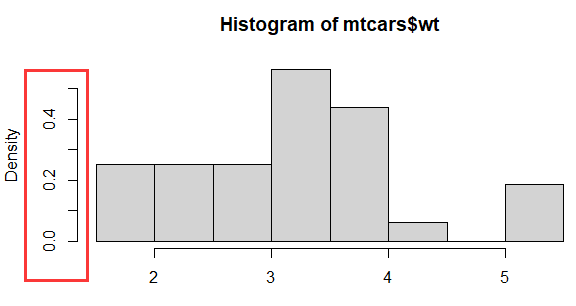
我们将考虑概率直方图(第二个),这意味着直方图的总面积为1。
hist(mtcars$wt, br=seq(0,6,by=0.5), freq=F, col="lightgreen",xlab="weight of cars (1000 lbs)",main="Histogram of Weights of Cars US 1973-74")
br=seq(0,6,by=1) seq是(开始, 结束, by=步长)

ggplot直方图
使用aes(y=…density…)将原始直方图转换为概率直方图。
p = ggplot(data=mtcars, aes(x=wt)) # Select the mtcars data, and focus on wt (quantitative) on x axis
p + geom_histogram(aes(y=..density..),binwidth=0.5)
+ xlab('Weight')+ylab('Density') # Produce a histogram with x and y axis labels
箱线图
箱线图是定量变量的另一个摘要。
产生一个单一的汽车的重量箱线图。
boxplot(mtcars$wt)
boxplot(mtcars$wt, horizontal = T)

用在箱线图中boxrpolt(y~x1),表示将x1视作分组变量,分组输出y1的箱线图
boxplot(mtcars$wt~mtcars$cyl)
boxplot(mtcars$wt~mtcars$cyl, names=c("4 cyl", "6 cyl","8 cyl"),ylab="Weight of cars (1000 lbs)")
ggplot箱线图
p = ggplot(data=mtcars, aes(x="", y=wt))
# Select the mtcars data, and focus on wt (quantitative) on y axis (with no filtering on x axis)
p + geom_boxplot() # Produce a boxplot
双箱线图
p = ggplot(data=mtcars, aes(x=factor(cyl),y=wt)) # Select the mtcars data, and focus on wt (quantitative) on y axis and cyl (qualitative) on x axis
p + geom_boxplot() # Produce a boxplot, of wt filtered by cyl
![]()
geom_jitter绘制带有少量随机噪声的点。我们使用它来调查小数据集中的过度绘图。有时候,数据量大,我们需要显示每一个数据点,可以很直观的看到数据的分布情况。在文章中这种图是很常见的。我们只需要在上面的箱形图中加入geom_jitter函数就可以啦
p = ggplot(data=mtcars, aes(x=factor(cyl),y=wt))
p + geom_boxplot() + geom_jitter()
p = ggplot(data=mtcars, aes(x=factor(cyl),y=wt))
p + geom_boxplot() + coord_flip() #横向转换坐标:把x轴和y轴互换,没有特殊参数
p + geom_boxplot(notch = TRUE)
p + geom_boxplot(outlier.colour = "green", outlier.size = 3) #outlier 异常处理
notch参数:如果为假(默认),则制作标准盒图。如果为真,做一个缺口盒图。凹槽用来比较组;如果两个盒子的凹槽不重叠,说明中位数有显著差异。notchwidth参数:如果指定notch参数为TRUE的话,指定切口宽度,默认0.5。
boxplot(mpg~cyl,data=mtcars,notch=TRUE,col="green",xlab="Number of Cylinders",ylab="MPG",main="Boxplot for MPG by Number of Cylinders")

p + geom_boxplot(aes(fill = factor(cyl)))
p + geom_boxplot(aes(fill = factor(am)))
Mosaicplot 马赛克图 暂时不讲
counts2 = table(mtcars$gear, mtcars$am) # Produces contingency table
plot(counts2) # Produces mosaic plot from contingency table

https://cran.rproject.org/web/packages/ggmosaic/vignettes/ggmosaic.html
散点图
plot(mtcars$wt,mtcars$mpg)
plot(mtcars$wt,mtcars$mpg, xlab="Car Weight", ylab="Miles per Gallon",col="darkred",pch=19)
abline(lm(mtcars$mpg~mtcars$wt))
lm是用来适应线性模型的。它可用于进行回归、单层分析方差分析和协方差分析。
Usage
lm(formula, data, subset, weights, na.action,
method = "qr", model = TRUE, x = FALSE, y = FALSE, qr = TRUE,
singular.ok = TRUE, contrasts = NULL, offset, ...)
Arguments | 参数
- formula:指要拟合的模型形式,
- data:是一个数据框,包含了用于拟合模型的数据。
Example | 例子
lm(mtcars$mpg~mtcars$wt)

abline 函数的作用是在一张图表上添加直线(参考线), 可以是一条斜线,通过x或y轴的交点和斜率来确定位置;也可以是一条水平或者垂直的线,只需要指定与x轴或y轴交点的位置就可以了

plot(mtcars)
pairs(~mpg+disp+drat+wt,data=mtcars)
用在回归模型中lm(yx1+x2),右边为自变量,左边为因变量。
pairs(mtcars)
ggplot中散点图的使用
p = ggplot(mtcars, aes(wt, mpg)) # Select the mtcars data, and focus on wt (quantitative) on x axis and mpg (quantiative) on y axis
p + geom_point() # Produce a scatterplot of mpg vs wt
p + geom_point(aes(colour = factor(cyl))) # Colour the points by cyl (qualitative)
下面几个颜色绘制方法等价
aes(col = x)
aes(fg = x)
aes(color = x)
aes(colour = x)

p + geom_point(aes(shape = factor(cyl))) # Shape the points by cyl (qualitative)
p + geom_point(aes(shape = factor(cyl))) + scale_shape(solid = FALSE)
p + geom_point(aes(size = qsec)) # Size the points by qsec (qualitative)
p + geom_point(aes(colour = cyl)) + scale_colour_gradient(low = "blue") # Colour the points by cyl (quantitative)
install.packages("plotly")
library("plotly")
p1 = plot_ly(mtcars, x = ~mpg, y = ~wt, type="scatter")
print(p1)
ggplot2
函数可用以下的代码模板概括:
ggplot(data = ) +
(
mapping = aes(),
stat = ,
position =
) +
+
其中,这7个参数分别为数据集(DATA)、几何对象( GEOM_FUNCTION)、映射集合(MAPPING)、统计变换(STAT)、位置调整(POSITION)、坐标系(COORINATE_FUNCTION)和分面模式(FACET_FUNCTION)。
这套模板也可以作为我们学习ggplot2的总领,搞清楚每幅图中的这7个参数并能熟练地运用它们,在可视化这个领域就有了“初窥门径”的境界了。
废话不多说,接下来就拆开这套函数,将7个参数逐个击破。
关于要输入ggplot的数据其实应该在可视化之前就处理好了,但是要注意的是输入的是数据类型必须要是data.frame(or other object coercible by fortify() ?)。
在上游处理好数据后,便可以使用ggplot进行可视化处理。
映射集合
在使用aes()函数确定x、y轴的关系以及数据后,就可以作图了。以下用ggplot2包中自带的数据集mpg进行绘图(散点图)
displ 和 hwy 是 数据集mpg中的列名
ggplot(data = mpg) + geom_point(aes(x=displ, y=hwy))
#hwy:highway miles per gallon
#displ:engine displacement, in litres
factor(变量)
R语言绘图
使用ggplot2绘图
导入依赖
library(ggplot2)
绘制柱状图
> mtcars$gear
[1] 4 4 4 3 3 3 3 4 4 4 4 3 3 3 3 3 3 4 4 4 3 3 3 3 3 4 5 5 5 5 5 4
> class(mtcars$gear)
[1] "numeric"
> barplot(mtcars$gear)
- 统计一组数中元素的情况
> table(mtcars$gear)
3 4 5
15 12 5
> counts = table(mtcars$gear)
> barplot(counts)
> barplot(counts, names.arg = c("3 gears","4 gears", "5 挡"))
> barplot(counts, names.arg = c("3 gears","4 gears", "5 挡"), col="red")
> barplot(counts, names.arg = c("3 gears","4 gears", "5 挡"), col="lightblue")
> barplot(counts, names.arg = c("3 gears","4 gears", "5 挡"), col="pink")
> par(las=2)
> barplot(counts, names.arg = c("3 gears","4 gears", "5 挡"), col="pink")

多个条状图绘制

上面这样没有图例很难辨认数据的情况
指定字段绘制图形
> counts1 = table(mtcars$cyl, mtcars$gear)
> counts1
3 4 5
4 1 8 2
6 2 4 1
8 12 0 2
> barplot(counts1, names.arg = c("3 gears","4 gears", "5 gears"), col=c("pink", "blue", "yellow"),legend=rownames(counts1))
> rownames(counts1)
[1] "4" "6" "8"
> barplot(counts1, names.arg = c("3 gears","4 gears", "5 gears"), col=c("pink", "blue", "yellow"),legend=c("4 cyl", "6 cyl","8 cyl"))
> barplot(counts1, names.arg = c("3 gears","4 gears", "5 gears"), col=c("pink", "blue", "yellow"),legend=c("4 cyl", "6 cyl","8 cyl"), beside = TRUE)
> ggplot(mtcars) # ggplot函数没有任何显示, 这里只是做数据集等准备操作
> p = ggplot(mtcars)
> p + geom_bar()
错误: stat_count() requires an x or y aesthetic.
Run `rlang::last_error()` to see where the error occurred.
> p = ggplot(mtcars, aes(x=factor(cyl))) #指定 cyl为横坐标
> p + geom_bar()
更换数据集mpg绘图
> p1 = ggplot(mpg, aes(class))
> aes(class)
Aesthetic mapping:
* `x` -> `class`
> table(mpg$class)
2seater compact midsize minivan pickup subcompact suv
5 47 41 11 33 35 62
> p1 + geom_bar()
![]()
p1 = ggplot(mpg, aes(class))
# p1 + geom_bar(aes(weight=displ))
p1 + geom_bar(aes(weight=year)) # 这里是属于这类所有值的相加
p1 = ggplot(mpg, aes(class))
p1 + geom_bar(aes(fill= drv)) # fill 是让ggplot自动根据因子的水平分数分配颜色等值
p1 = ggplot(mpg, aes(class))
# p1 + geom_bar(aes(fill= drv)) # fill 是让ggplot自动根据因子的水平分数分配颜色等值
# 水平
p1 + geom_bar(aes(fill= drv), position = position_stack(reverse = TRUE))+ coord_flip() + theme(legend.position = "bottom")
直方图
> hist(mtcars$wt)
# 变成总面积为1的概率分布直方图
> hist(mtcars$wt, freq = F)

直方图参数增加
br 横坐标刻度范围 xlab横轴标签 main是标题
hist(mtcars$wt, freq = F, br=seq(0, 6, by =0.5),col = 'red', xlab = 'weight of cars', main = '车重直方图')
举一反三
> barplot(mtcars$wt, xlab = "车的重量", ylab = "数量", main = "数据标题", col = 'yellow')
ggplot 直方图
p = ggplot(data=mtcars, aes(x=wt))
# 使用 aes(y=..density..) 将原始直方图变成概率直方图
p+geom_histogram(aes(y=..density..), binwidth = 0.5)+xlab("Weight") + ylab('density')
![]()
箱线图
boxplot(mtcars$wt)
boxplot(mtcars$wt, horizontal = T)

用在箱线图中的~: boxplot(y~x1),表示将x1视作分组变量, 分组输出y1的箱线图
boxplot(mtcars$wt~mtcars$cyl)
boxplot(mtcars$wt~mtcars$cyl, names=c("4 cyl", "6 cyl","8 cyl"), ylab = "weight of cars (1000lbs)")
ggplot箱线图
p = ggplot(data=mtcars, aes(x="", y=wt))
p + geom_boxplot()
p = ggplot(data=mtcars, aes(x=factor(cyl), y=wt))
p + geom_boxplot()
p = ggplot(data=mtcars, aes(x=factor(cyl), y=wt))
p + geom_boxplot()+geom_jitter()
p = ggplot(data=mtcars, aes(x=factor(cyl), y=wt))
> p + geom_boxplot()+ coord_flip() # 横向转换坐标:把x轴和y轴互换, 没有特殊参数
p + geom_boxplot(notch = TRUE)
会有凹槽用来比较组, 两个盒子凹槽不重叠, 说明中位数有显著差异

p + geom_boxplot(outlier.colour = "green", outlier.size = 5)
boxplot(mpg~cyl, data = mtcars, notch=TRUE, col='green')
散点图
特性: 两个变量之间的关系分布图
plot(mtcars$wt, mtcars$mpg)
plot(mtcars$wt, mtcars$mpg, xlab = "Car weight", ylab = "Miles per Gallon", col="red", pch=17)
![]()
数据拟合
plot(mtcars$wt, mtcars$mpg, xlab = "Car weight", ylab = "Miles per Gallon", col="red", pch=17)
abline(lm(mtcars$mpg~mtcars$wt))
# lm 是线性模型的意思
Usage
lm(formula, data, subset, weights, na.action,
method = "qr", model = TRUE, x = FALSE, y = FALSE, qr = TRUE,
singular.ok = TRUE, contrasts = NULL, offset, ...)
-formula:指要拟合的模型形式,
- data:是一个数据框,包含了用于拟合模型的数据。
lm(mtcars$mpg~mtcars$wt) 对 mpg和wt进行线性模型分析, 中间用~
![]()
abline 函数的作用是在一张图表上添加直线(参考线), 可以是一条斜线,通过x或y轴的交点和斜率来确定位置;也可以是一条水平或者垂直的线,只需要指定与x轴或y轴交点的位置就可以了

plot
plot(mtcars)
pairs(mtcars)
plot(~mpg+disp+drat+wt,data = mtcars)
ggplot散点图
library(ggplot2)
p = ggplot(mtcars, aes(wt, mpg))
> p + geom_point()
p = ggplot(mtcars, aes(wt, mpg))
p + geom_point(aes(colour = factor(cyl)))
p = ggplot(mtcars, aes(wt, mpg))
p + geom_point(aes(colour = cyl))
p = ggplot(mtcars, aes(wt, mpg))
p + geom_point(aes(colour = factor(gear)))

下面几个颜色绘制方法等价
aes(col = x)
aes(fg = x)
aes(color = x)
aes(colour = x)
p = ggplot(mtcars, aes(wt, mpg))
p + geom_point(aes(shape = factor(cyl)))
p + geom_point(aes(shape = factor(cyl))) + scale_shape(solid = FALSE)
p = ggplot(mtcars, aes(wt, mpg))
p + geom_point(aes(size=qsec))
p = ggplot(mtcars, aes(wt, mpg))
p + geom_point(aes(color=cyl)) + scale_colour_gradient(low = "red")
p = ggplot(mtcars, aes(wt, mpg))
p + geom_point(aes(color=cyl, size=qsec)) + scale_colour_gradient(low = "red")
plotly
install.packages("plotly")
p = plot_ly(mtcars, x=~mpg, y=~wt, type="scatter")
print(p)
基本统计数值
数据总结

查看筛选子集的的统计结果
选择重量大于或等于 3 的汽车的 mpg的统计结果
summary(mtcars$mpg[mtcars$wt >=3])
mtcars[which(mtcars$cyl==6),]
相关系数
cor(mtcars)
绘制曲线
先删除所有变量
rm(list=ls())
绘制曲线
> par(mfrow=c(3, 1)) # 几行几列
> curve(dnorm(x), -1, 1) # curve(函数, 范围)
> curve(dnorm(x), -5, 5) # curve(函数, 范围)
> curve(sin, -2*pi, 2*pi) # curve(函数, 范围)
- dnorm(x, mean = 0, sd = 1, log = FALSE) 的返回值是正态分布概率密度函数值,比如dnorm(z)则表示:标准正态分布密度函数f(x)在x=z处的函数值。
- pnorm(q, mean = 0, sd = 1, lower.tail = TRUE, log.p = FALSE) 返回值是正态分布的分布函数值,比如pnorm(z)等价于P[X ≤ z]
- qnorm(p, mean = 0, sd = 1, lower.tail = TRUE, log.p = FALSE) 的返回值是给定概率p后的下分位点.
- rnorm(n, mean = 0, sd = 1) 的返回值是n个正态分布随机数构成的向量。
曲线绘制
- dnorm(x, mean = 0, sd = 1, log = FALSE) 的返回值是正态分布概率密度函数值,比如dnorm(z)则表示:标准正态分布密度函数f(x)在x=z处的函数值。
- pnorm(q, mean = 0, sd = 1, lower.tail = TRUE, log.p = FALSE) 返回值是正态分布的分布函数值,比如pnorm(z)等价于P[X ≤ z]
- qnorm(p, mean = 0, sd = 1, lower.tail = TRUE, log.p = FALSE) 的返回值是给定概率p后的下分位点.
- rnorm(n, mean = 0, sd = 1) 的返回值是n个正态分布随机数构成的向量。
curve(dnorm(x), xlim=c(-2, 2), ylab="",axes=FALSE,xlab = "")
axis(1, at=c(-2,-1,0,0.8,1,2), pos = 0)
# axis
# 第一个参数 side表示要操作的坐标轴,取值1、2、3、4分别代表下、左、上、右;
# at表示刻度线及刻度值所在位置;
# pos 表示轴线所在的位置
填充颜色
以数据(x,y)为坐标,依次连接所有的点,绘出一个多边形
x = 1:10
y = rnorm(x)
x1 = c(2, 4, 4)
y1 = c(0, 0, 1)
plot(x, y, type = 'l')
polygon(x, y, col='green')
polygon(x1, y1, col='red')
curve(dnorm(x), xlim = c(-2, 2), ylab = "", axes=FALSE)
abline(h=0)
sequence = seq(-2, 0.8, 0.1)
polygon(x =c(sequence, 0.8, -2), y=c(dnorm(c(sequence)), 0, 0), col='purple')
axis(1, at=c(-2,-1,0,0.8,1,2), pos = 0)
直方图添加正太曲线
hist(mtcars$wt, prob=T) # prob=T指定为频率 默认是频数
m =mean(mtcars$wt)
s =sd(mtcars$wt)
curve(dnorm(x, mean = m, sd = s), col='red', lwd=2, add = TRUE)
# lwd=2线的宽度 # add=TRUE 代表加载直方图上
![]()
要计算 P(Z < 0.8),请使用pnorm.
pnorm(0.8)
[1] 0.7881446
计算 P(Z > 0.8):
第一种

第二种

计算 P(0.3 < Z < 0.7):

![]()
上面是均值为5 标准差为4

线性模型
先生成散点图
plot(mtcars$mpg, mtcars$wt, xlab = "mpg", ylab = "weight", main = "scatter of mpg vs wt")
plot(mtcars$mpg, mtcars$wt, xlab = "mpg", ylab = "weight", main = "scatter of mpg vs wt")
L = lm(wt~mpg, data = mtcars)
# 因变量 ~ 自变量
abline(L, col='red', lwd=3)
L = lm(wt~mpg,data=mtcars)
plot(mtcars$mpg,L$residuals, xlab = "mpg", ylab = "Residuals")
abline(h = 0, col = "blue")

